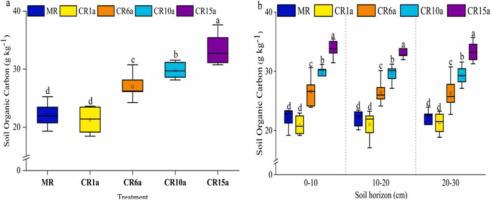Agriculture, Ecosystems & Environment ( IF 6.6 ) Pub Date : 2022-01-24 , DOI: 10.1016/j.agee.2022.107857 Zhen Zhang 1, 2 , Linsen Du 1, 2 , Zhiyu Xiao 1, 2 , Chunwang Li 1, 2 , Zhichang Wang 1, 2 , Pingyao Zhou 1, 2 , Geng Sun 1, 2 , Yingying Ye 1, 2 , Teng Hu 1, 2 , Hua Wang 1, 2

|
Soil in agriculture systems is important for carbon sequestration. To explore the influence of rice-crayfish farming on soil organic carbon (SOC) content, 0–30 cm soil samples were collected from rice monoculture and rice-crayfish systems (1, 6, 10 and 15 years) scattered in Nanxian County, Hunan Province, China. Results showed that the SOC content in rice monoculture was approximately 22 g kg−1, while enhanced SOC content was observed in 6, 10 and 15-year rice-crayfish systems, around 27–33 g kg−1. The formation of water-stable aggregates mainly depends on the cementation of SOC. Meanwhile, the decomposition of organic matter may further lower the oxygen content and lead to accumulation of reduction substances in soil. Similar increasing trends also occurred in soil water-stable macro-aggregates (WR0.25) content (78–83%), mean weight diameter (MWD) (1.1–1.2 mm) and geometric mean diameter (GMD) (0.8–1.0 mm), whereas the aggregate fractal dimension (D) (2.58–2.44) decreased. Moreover, rice-crayfish farming over 6 years enhanced the content of total reducing matter (TRM), active reducing matter (ARM), Fe2+ and Mn2+ content by 1.7–3.4 cmol kg−1, 0.6–1.3 cmol kg−1, 0.5–1.2 cmol kg−1 and 0.2–0.6 cmol kg−1, respectively. However, the 1-year rice-crayfish system did not show significant changes after the conversion from rice monoculture systems. Overall, rice-crayfish farming has the capability to increase and preserve SOC, but it aggravates soil gleization.


























 京公网安备 11010802027423号
京公网安备 11010802027423号